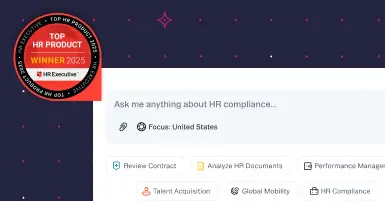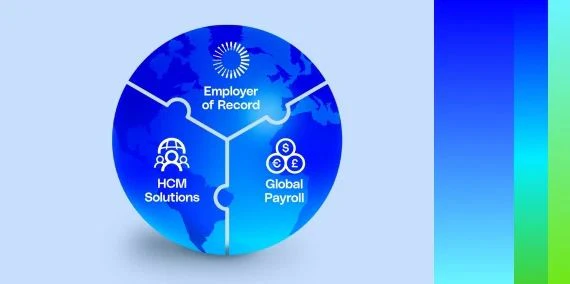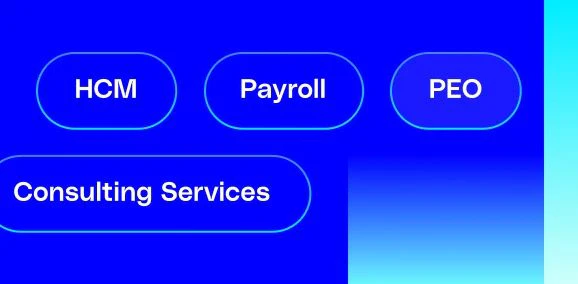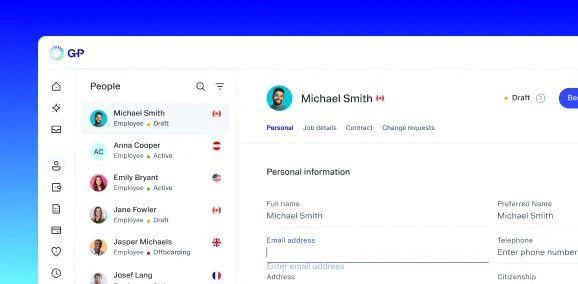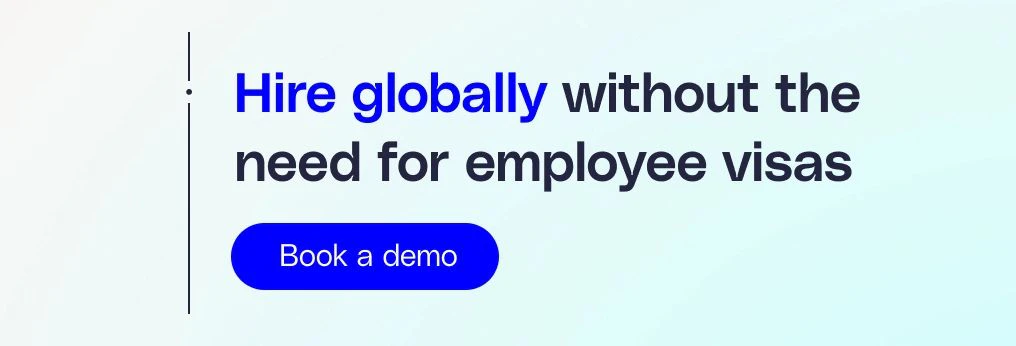
Key takeaways
-
Purpose and eligibility: The H-1B is a visa that allows U.S. employers to temporarily hire international workers for "specialty occupations." These jobs typically require a bachelor's degree or higher in a specific field, such as IT, science, engineering, or medicine.
-
Employer-sponsored process: The U.S. employer, not the international worker, must sponsor and file the petition.
-
Annual cap and lottery: There’s a strict annual limit on H-1B visas (65,000 regular visas plus 20,000 for U.S. master's degree holders), which makes the selection process highly competitive and often results in a lottery system.
-
Significant cost: Starting September 19, 2025, employers must pay a USD 100,000 fee for new H-1B petitions.
It’s no secret: Companies want to hire top talent. But hiring employees who aren’t U.S. citizens or residents of the U.S. can be a complicated process. In most cases, companies would have to sponsor international talent through a visa program.
Don’t let the visa process deter you from hiring international talent. Let’s explore the U.S. visas available to international workers – and the H-1B alternatives that can help you cut costs, time, and headaches.
Understanding the visa basics
Citizens of other countries typically need toa visa before they can travel to the United States. The exception to this rule is travelers who are from a country that participates in the Visa Waiver Program (VWP). The VWP lets citizens of certain countries travel to the U.S. for tourism or business for up to 90 days without a visa. Anyone else – particularly anyone who wishes to work in the U.S. – needs a visa to do so.
A visa doesn’t guarantee that someone will be allowed to enter the U.S., but it does inform customs officers that a U.S. embassy or consulate has reviewed a person’s background and determined that they’re eligible to travel to the country for the purpose stated on the visa.

Visa categories
There are several sub-categories, but U.S. visas typically fall into two broad groups: immigrant visas and non-immigrant visas. The main difference between the two is the reason for the person’s travel to the U.S. An H-1B visa is a non-immigrant visa, which lets U.S. employers temporarily employ international workers in specialty occupations.
What’s the difference between an immigrant and non-immigrant visa?
Applicants for immigrant visas are typically seeking lawful permanent resident status (a “green card”). These are meant for those who hope to live in the U.S. permanently.
Examples include visas given to:
-
Children from countries who are being adopted by U.S. families (IR-3, IR-4 visas)
-
Spouses (IR-1, CR-1)
-
Fiancés of U.S. citizens (K-1)
-
Certain employer-sponsored immigrants (like EB-1, EB-2, EB-3 categories)
People who have a permanent residence or citizenship outside of the U.S., but hope to travel to the country temporarily, can apply for a non-immigrant visa. More than 20 different types of non-immigrant visas are available.
Categories include:
-
Tourism visas
-
Student visas
-
Performing artist or athlete visas
-
Exchange visitor visas (such as an au pair visa)
-
Occupations in fields requiring highly specialized knowledge (H-1B)
It’s important to remember that non-immigrant visas are for a specific, limited duration and purpose.
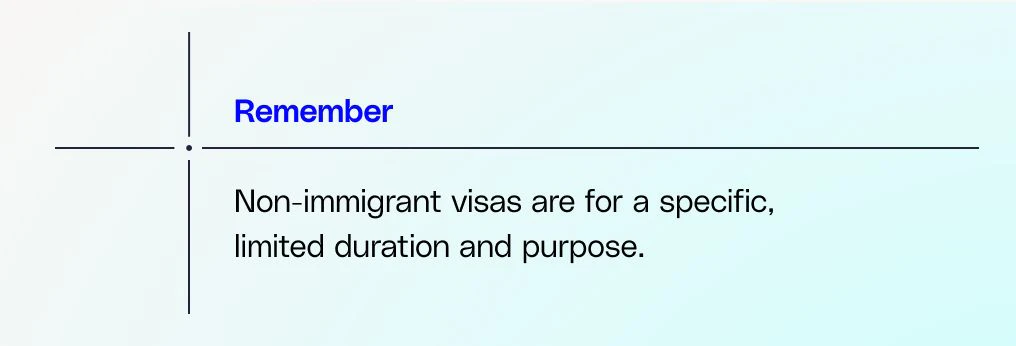
About the H-1B visa
The H-1B visa is available to those who perform services in a specialty occupation as well as to fashion models who have a unique ability or merit (H-1B3). People who are going to provide services of exceptional talent and value to a Department of Defense development and cooperative research project (H-1B2) are also included.
A very limited number of H-1B visas are available annually. Employers who want to hire international talent need to apply for the visa on behalf of the employee. Individuals can’t apply for an H-1B visa on their own.
2025 H-1B visa cost
Starting September 19, 2025, employers pay a USD 100,000 fee for new H-1B petitions. This fee is a one-time, nonrefundable payment that applies to the upcoming 2026 lottery cycle and any new petitions submitted after September 21, 2025. This fee only applies to new applicants and won’t affect current visa holders or those renewing their visas.
Which occupations qualify for the H-1B visa?
To qualify for the H-1B visa, occupations need to meet specific requirements. The position must fulfill at least one of the following:
-
Employees in the occupation need at least a bachelor’s degree.
-
The occupation is unique or complex enough that a person needs a degree to perform the duties and responsibilities required.
Specialty occupations are often found in accounting, IT, science, medicine, and mathematics. In 2025, Amazon, Tata, Microsoft, and Meta were among the U.S.-based companies with the most H-1B applications approved. Amazon had more than 10,000 H-1B visa applications approved in 2025.
Type of work and position complexity aren’t the only things that influence whether or not an occupation qualifies for an H-1B visa. The employee also needs to fulfill specific requirements.
Qualified H-1B candidates need to meet at least one of the following:
-
They have a bachelor’s degree or higher from an accredited university or college in the United States. The degree should be in the subject of the specialty occupation.
-
They have a degree from an international university that’s the equivalent of a U.S. bachelor’s degree or higher. The degree should be in the subject of the specialty occupation.
-
They have a state license, certification, or registration that is unrestricted and allows them to practice the specialty occupation.
-
They have training, education, or have experience in the area of specialty that is equivalent to the completion of a bachelor’s degree or higher. They must also have recognized expertise in the occupation by holding progressively responsible positions in that specialty.
How long does the H-1B visa last?
The H-1B visa is a non-immigrant visa and isn’t meant to allow a person to remain in the U.S. indefinitely. It has a time limit. Generally speaking, H-1B visas are valid for three years. Though it’s possible to extend the visa beyond that period, allowing a person to live and work in the U.S. for up to six years.
After six years, an H-1B visa-holder may be able to extend their visa for another year if they submit an I-40 immigration petition, or if their I-40 petition has been approved and they haven't yet received their green card. More extensions are possible if the green card process is underway and certain conditions are met.
How do you apply for an H-1B visa?
Individuals interested in working for a U.S. company can’t apply for the H-1B visa on their own. It’s the company's responsibility to start the process.
The first step for an employee: Complete and submit a Labor Condition Application (LCA) to the U.S. Department of Labor.
The LCA requires the employer to verify that:
-
The international worker will be paid at least the prevailing wage for the position in the geographic area.
-
The employment of the H-1B worker won’t adversely affect the working conditions of similarly employed U.S. workers.
-
The LCA is filed electronically through the DOL’s online system.
After the DOL has certified an employer’s LCA, it can proceed with the H-1B application process. The next step is to complete Form I-129 and submit it to the U.S. Citizenship and Immigration Services (USCIS).
Along with Form I-129, an employer needs to file:
-
The certified LCA
-
Evidence that the position qualifies as a specialty occupation
-
Proof of the employee’s qualifications (degree, license, etc.)
-
A copy of the employment contract or offer letter
Once the employer has submitted the appropriate paperwork and the Form I-129 has been approved by USCIS, the H1-B employee needs to apply for an H-1B visa at a U.S. embassy or consulate.
How to increase your chances of approval
You can take a few steps to improve your chances of approval:
-
Get a master’s degree. A master’s degree can improve the applicant’s chances of selection. The H-1B cap includes an advanced degree exemption for beneficiaries who have obtained a U.S. master’s degree or higher. This exemption is available until the number of qualified beneficiaries surpasses 20,000.
-
Watch your deadlines. Get your registration and application submitted as soon as possible. Sometimes, USCIS meets its quota of petitions in as little as five days after opening them for submission. Once they reach this amount, they will stop accepting any more petitions, so you’ll want to get the submissions in as soon as possible. The initial registration period is usually open for a short window in March. Give yourself plenty of time to get things ready beforehand. You’ll likely need to talk with lawyers, get information from the employee, and consult with your HR representatives. Do this far in advance, so your submission is ready to go, and don’t forget to account for the processing times.
-
Don’t have the applicant pay the fee. Legally, the company acting as the sponsor must pay the visa fees. The fee starting September 19, 2025, is USD 100,000. If USCIS finds out the employee paid them, they may deny the visa. The employee can pay the expedited processing fee if they wish to receive their results sooner. It must be completely of their own accord, though. Many companies will offer to pay this fee for the employee if they want them to start working sooner, but you can’t ask the applicant to cover it.
-
Don’t double-dip. If the same company, including any affiliates and partner companies, puts an applicant in the pool twice, you run the risk of getting immediately denied. Even if the entities are technically separate companies, any overlap in corporate ownership or control could get you denied.
-
Meet employer requirements. Smaller companies or those that have never done the H-1B process before may have a harder time proving that their business is legitimate. You’ll need the right tax documents and proof you can pay the employee a steady wage. USCIS can ask for a wide variety of documents to confirm this. The important part is to show your company is a sustainable business with long-term plans and projections.
Are there limits or restrictions on the H-1B visa?
A limited number of H-1B visas are available each year. So not every company or employer who wants to hire H-1B workers might be able to. There’s a cap of 65,000 regular H1-B visas each year and a cap of 20,000 H-1B visas that qualify for the advanced degree exemption (meaning the employee holds a master’s degree or higher from a U.S. institution).
Applications often far exceed the number of visas available, which is why the lottery is in place. This lottery-based system means there’s no guarantee of success, even after the 6-12 month application process and the nonrefundable USD 100,000 fee.
How do families of H-1B visa holders come to the U.S.?
If a H-1B visa holder has a spouse or dependent children under the age of 21, who would like to move to the U.S. with them, those family members will also need a U.S. visa.
Unless a person’s spouse is also an employee in a specialty occupation, it’s unlikely that they will receive an H-1B visa as well. Instead, they will more likely get an H-4 visa, which is for dependents. Family members can apply for the H-4 visa after the employee’s H-1B visa is approved. H-4 visa holders are generally not authorized to work in the U.S. by default. If family members who obtain H-4 visas are interested in working while they’re in the U.S., they can apply for an Employment Authorization Document (EAD).
The benefits of hiring international specialty workers
Hiring international employees can benefit your business in several ways.
If you’ve struggled to find qualified candidates in the U.S. or you’re facing H-1B visa challenges, expanding your search to global talent pools can increase your likelihood of finding the best fit for the role.
Another benefit of hiring an international employee for a specialty occupation is that it can increase your global footprint. If you hire someone who is bilingual or multilingual, you might find that your company can branch out into untapped markets or parts of the world. The new hire might also have connections in your target market and help you grow your customer base.
When your company hires employees from other countries, you also increase the diversity of your workforce. A more diverse workforce is often better equipped to handle and solve problems, as people bring a range of experiences and opinions to the table.
Get over the H-1B visa paywall. Access global talent with the #1 EOR.
Applying for an H-1B visa is just one way to hire specialized employees. Tap into global markets and hire the talent you need with an employer of record (EOR). An EOR is a third-party organization that legally employs international talent on your behalf and handles all employment responsibilities such as contracts, payroll, benefits, compliance, and tax filings. This model allows you to hire and onboard global employees without the visa price tag or hassle of entity setup.
With G-P, you can:
-
Hire the talent you need, wherever they live. The EOR model provides 100% certainty, unlike the H-1B lottery.
-
Optimize your hiring budget. Allocate your HR budget strategically and maximize ROI by avoiding costly visa fees and legal expenses. The H-1B process has a USD 100,000 upfront government fee, while the EOR model has a USD 0 upfront government fee.
-
Accelerate time-to-value: Get results without lengthy waiting periods. You can onboard new talent in days with an EOR, compared to the 6-12 months it can take for an H-1B visa.
If you’re ready to start hiring globally, request a proposal today.


